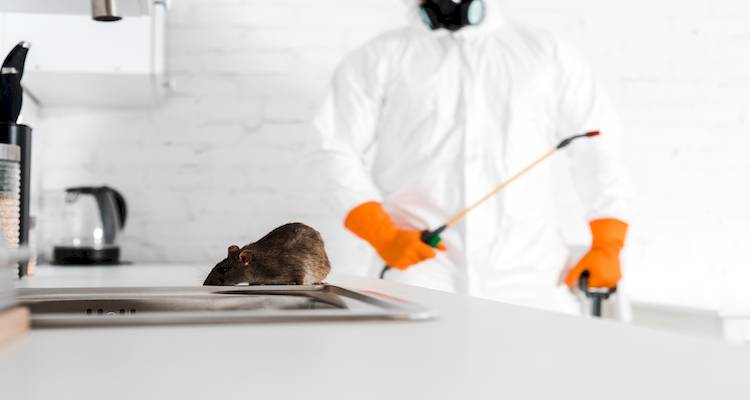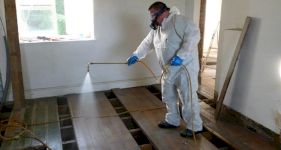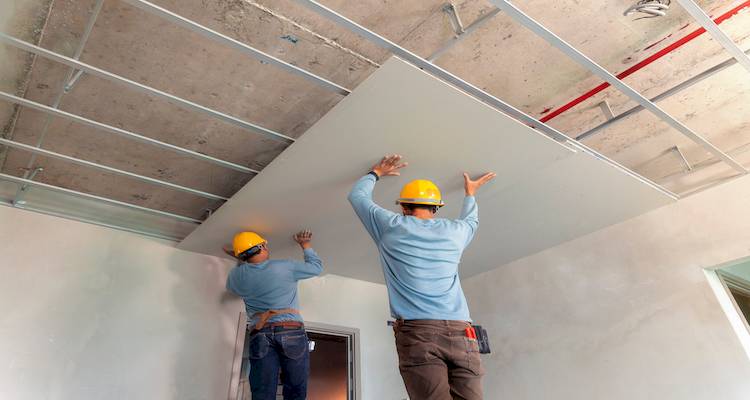Rat Exterminator Costs
- The average rat exterminator costs around £100 to hire in 2025.
- It takes approximately 3 to 6 weeks to carry out rat extermination.
- The average cost of rat removal in the UK, as well as what impacts the rat exterminator prices you're quoted.
- How to identify a potential pest problem in your home, such as rats in your attic, garden, or garage.
- How to find and hire a rat exterminator near you.
Looking to find out how much it costs to get rid of rats in your home?
The average cost of rat removal can range between £80 and £150 in the UK.
In this guide, we will cover rat exterminator costs, the signs that suggest you may have a pest problem in your home, and what to consider when hiring a pest control specialist.
So, if you want to know how to control and remove the pests in your home, keep reading.

£100
Table of Contents
- How Much Is Pest Control for Rats?
- Rat Exterminator Supply Costs
- Additional Rat Exterminator Costs
- Rat Exterminator Labour Costs and Timescales
- What Impacts the Cost of Pest Control for Rats?
- How Do I Know If I Have A Rat Infestation?
- What's Involved in Rat Extermination?
- Can I Exterminate Rats Myself?
- Types of Rat Extermination
- Checklist: Hiring a Rat Exterminator in the UK
- Sources
How Much Is Pest Control for Rats?
The cost of hiring a rat exterminator can range between £80 and £150. This price, however, can vary according to the size of the infestation and the number of rats to catch.
If your home has been overtaken by rats and requires thorough cleaning and disinfection of corpses, this will cost more than catching live pests. As well as removing the dead rats, your exterminator will also have to clear any other contamination caused by rodent droppings and urine nesting materials.
And, if it's obvious that your home or business has become riddled with rats and you require a 24-hour on-call service, the cost will be higher than the average pest control job as a result of the urgency.
Rat Exterminator Prices
The average cost of rodent removal is £100.
| Job | Cost |
|---|---|
| Average Cost | £100 |
| Rat Exterminator | £80 – £150 |
Rat Exterminator Supply Costs
You can buy a rat trap for £9 to £20. This high-volt electric shock kills the rat rapidly and painlessly when it moves on two metal plates and completes the circuit. They are suitable for use in farmhouses, dry barns, and outbuildings.
Rat poison costs £6 to £15 depending on the amount and quality of the rat poison.
Rat killer kits cost £15 to £35. Rat killer kits mix the best products to eliminate your rat pest problem quickly and effectively.
Rat trap cages are excellent for use in gardens or at home, and usually cost £19 to £20. Rat cages are meant to capture rats without endangering other animals that may enter by accident, as no poisons or 'snap traps' are used.
You can also use an at-home outdoor repellent, which usually plugs into an electrical socket and emits a sound that only rodents can hear. These typically cost £20 and £30.
Additional Rat Exterminator Costs
While eliminating rats from your property, you could decide to have additional work done to safeguard your home and garden against future pests. Let's go over these additional costs, so you know what to expect.
Wheelie Bin Cover Cost
Rats are attracted to where food is stored - which can mean that the smell of your bin can end up bringing rats to your home. An effective way to prevent this from happening is with a wheelie bin cover or store.

The material cost to build a wheelie bin store is around £100 for a standard single bin store. The more complex the design, the higher the price, with triple bin designs costing over £500.
The average carpenter will typically charge around £150 per day to build you a wooden bin cover.
Pest Control Cost
If you have other pests in your home, it could be good to have pest control come in and eliminate this problem. Pest control costs vary depending on the type of intruder, and once the specialists recognise the pests or their location, they will decide which method to use.
For example, the average treatment costs for a single wasp nest or cockroaches are £50, but treating carpets or furniture for various fleas can raise the price to £150.
Bed bugs have the highest pest control costs due to their stubbornness to leave your soft furnishings, with the extermination taking longer to finish and sometimes requiring multiple treatments, with costs reaching nearly £250 - but, this figure may be higher if bed bugs have infiltrated several rooms in your home.
Cost to Reseal Windows and Doors
If a rat has made its way into your home through cracks and openings in your entryways, you'll want to reseal your windows and doors. The average price of resealing your doors and windows is determined primarily by the number of windows and doors being resealed.
The materials are relatively inexpensive, costing between £5 and £10.
The cost of resealing double glazed windows, single-glazed windows, and doors will typically range between £25 and £70 per window or door.
Outside Socket Cost
You could put an outside socket on the side of your house to use a rat repellent plug-in. For this task, your electrician's hourly rate is the main cost of installing an outdoor socket, a simple task that should take around 2 hours to complete.
Outdoor socket installation costs are around £85 for a low-cost socket in an easily accessible location. For a hard-to-reach location, you should expect to pay no more than £245.

The location of your outdoor socket can directly influence the difficulty and cost of your project. However, if you can be flexible and work with your electrician to select a location, you can save money.
To get quotes from rat exterminators in your area, you can enter your postcode to access responses through our free online system.
Rat Exterminator Labour Costs and Timescales
The price of labour is usually included with the overall cost of the rat elimination. Let's go through the timescales and what could increase the overall duration.
The length of time required to seal rats out of a home is determined by the home's condition and structure. Most homes take between half a day and a full day to seal.
For example, if you've identified a gap in a foundation wall where a pipe passes through, allowing rats to enter, a simple fix will take a few minutes to complete.
But, things can get more time-consuming at the other end of the spectrum. Multiple entrances, second-storey points of entry, sub-standard foundation vents, and other factors complicate matters and make repairs more difficult.
To add to this, the rats must then be trapped and removed once the house has been sealed. Both exclusion and trapping must be thorough and remove all rats, and potential entry points to be successful.
Trapping all the rats is more difficult than sealing up a house, and can necessitate more visits and effort than exclusion work alone.
What Impacts the Cost of Pest Control for Rats?
Several factors influence the cost of removing rats from your home. Let's take a look at the main points.

Type of Rat
Norway rats tunnel into the ground to build their nests and typically follow sewer pipes to infiltrate homes from below.
Roof rats, on the other hand, are unique. They gain access to attic spaces by tree climbing, and during the winter, they prefer to nest in thermal insulation.
Both species of rat present distinct difficulties to pest controllers, requiring different approaches to extermination. This is why it's important to get at least 3 quotes from pest controllers to review your options.
Dimensions of the Infested Area
The number of rats in the area isn't as important as the possibility of future infestations. As a result, the rat removal cost will typically be determined by the potential for rodent infestations to spread rapidly.
That implies the specialist will have to work fast and may have to use more material. This increased urgency could also raise the price.
Size in Square Feet
The size of the home generally influences the total cost of significant pest control services. However, it is not a precise science.
Without measuring your home, the technician will usually note the square footage. Unless you have an abnormally large property, you will not pay more in most cases.
Methods of Treatment
Trapping rodents is a time-consuming process, and if that's the only method available, it could significantly raise your price. As a result, it's important to enquire about the procedures your pest controller will use, as it can directly impact the price you pay.
You can expect to get a lower-cost deal if the pest controllers just place a few rodenticide bait boxes all over your house - this is especially true if no follow-up service is provided.
You should, however, insist on a mixture of rodent control techniques. This includes techniques such as trapping, baiting, or mechanical exclusion. It's also good to request a follow-up service visit, even just to remove dead animals.
Location
Prices are generally higher in major cities such as London and Manchester, and they tend to be higher in southern England.
However, the price also varies according to the extent of the problem, so if you caught your rat problem early, your price has the potential of being significantly lower than if you had litters living in various locations throughout your house.
How Do I Know If I Have A Rat Infestation?
Rats can be extremely persistent. They can be identified by scratching noises around the house, a strong ammonia odour, droppings, and footprints.
If they get into your home, they can ruin your insulation, flooring, and ceiling joists. They can also gnaw other items in the house, such as paper and plastic.
Rats can contaminate food and often carry diseases, which can lead to the transmission of Weil's disease, Rat-bite fever, and Salmonellosis. As a result, rat infestations must be addressed as soon as possible.
What's the smallest gap a rat can get through?
Unfortunately, it's difficult to keep rats out of your house because they can fit through gaps as small as 5mm.
They also prefer small spaces that provide adequate shelter, warmth, and closeness to food sources, so the ceiling and wall cavities are extremely popular.
If you suspect you have an infestation of rats in your home, you will almost certainly notice the following:
- Small black droppings on your property
- Nests found in cavities, lofts, floorboards, and cupboards
- Gnaw marks and damage to cables, surfaces, and food supplies
Treatment for infections varies greatly. Prevention is the best way to prevent an infestation, so make sure all small gaps 5mm or bigger are completely sealed with wire wool or similar.
To get rid of rats without hiring a professional pest control company, you can use poisons and traps from hardware stores. However, because these poisons can be extremely dangerous to humans and pets, and you must strictly adhere to the instructions.
What's Involved in Rat Extermination?
Removing rats effectively from your home is a time-consuming process. The use of poisons and traps around your home can be challenging, and handling corrosive materials is a job best handled by a professional pest controller.

Here are two situations in which you must hire a rat exterminator:
- When you find evidence of a rat infestation in your home, you should contact a rat exterminator
- After discovering the nest/den: once you've pinpointed the exact location of the infestation, it could be a nest or a burrow. After this point, you must immediately contact a professional to treat the infestation.
- A more complex rat control treatment is required in the most serious cases where the asset has already suffered extensive damage to surrounding key areas. This category most likely includes properties with large attic or basement areas.
Let's now go through the process of rat extermination:
Step 1
It's always necessary to inspect the potential rat entry points first. A rat extermination specialist will do so by inspecting the interior and exterior of your home. They will look for the signs mentioned above, such as rat droppings, marks or biting, and property damage.
Step 2
Once the infestation has been confirmed, your rat extermination specialist will look for entry points. Drains, drainpipes, sewers, and air vents are examples of these. They will then block these points to prevent further rat intervention.
Step 3
There are several methods for catching rats, including placing rat poison bait in tamper-resistant bait stations. After explaining it to you and agreeing to it, your specialist will set the trap, based on the severity of the infestation.
Step 4
Your rat extermination specialist should return after this. A follow-up visit will usually happen within 5 to 7 days of the initial visit to inspect the building and remove any rat corpses.
Can I Exterminate Rats Myself?
There are DIY methods for exterminating rats which can help to save time and money on hiring a pest control specialist. However, these routes should only be undertaken if you are aware of the risks and are comfortable with the procedures.

While DIY rat control products are a cost-effective way to control rat problems in low-risk areas, professional pest control is required in high-risk areas with more established rat colonies, or where there is a repeat infestation.
If you have a bigger infestation and cannot control it, you will need more specialised treatment that is not available in shops.
Examine The House
Before getting rid of rats, you must first conduct a thorough home inspection to determine where they're coming from.
Inspect the outside of your house for obvious access points, paying special attention to broken drains, cracks in your garage, gaps around vents, or spaces in the foundation.
Examine the vents, drains, equipment lines, and other possible access points inside your house. You can seal the entry points and set traps once you know where the rats are getting into the house.
Fill Any Gaps
Rats don't require a large entry point to enter your home - they can fit through a gap as small as 5mm. You should close any gaps in your interior and exterior walls with this in mind.
Replace these gaps with wire wool, steel kick plates, or caulk for long-lasting results. Check them a few times a month to ensure they're in good working order.
Cleaning
Rats adore shelter and hiding places. One of the most effective ways to get rid of rats without using poison is to simply remove their hiding places. To do this, remove clutter from your home, and move items away from the walls.
Keep all waste and food in closed bins, quickly clean up any spills, and clean your pipes and drains.
Consider Trapping
As rodenticides and harsh toxins have been banned, trapping has emerged as the most effective method of eliminating rats as a non-poisonous method of controlling rat populations.
If you're going to set your traps, make sure you use plenty of them, and place them in high-activity areas. For example, use peanut butter, unsalted seeds, bananas, or apples as bait.
Employ Natural Deterrent Techniques
A few simple, fresh ingredients can go a long way in effectively getting rid of rats.
You can try these natural alternatives:
- Spread peppermint oil, chilli powder, black pepper, and cloves along the outside of the house to deter rats from entering. Apply liberally along the line between your foundation and the ground.
- Sprinkle crushed pepper (or use pepper spray) near rat holes and openings. This irritates the rats' noses and airways, discouraging them from returning to your home.
When poison is put down by a pest control company, will they come back to check it and clear away any dead rats?
Types of Rat Extermination
Rat infestations happen frequently which can cause major issues. Rodents transmit diseases, pollute the environment, and threaten human health.
Fortunately, cutting-edge rat control methods have evolved significantly over time. We now have more and more effective methods than ever before for controlling rat populations.
Different rat capture methods have advantages and disadvantages. To help you to decide which option is best, let's look at the pros and cons of each solution.
Rat Traps
Rat traps are one of the first to have a high success rate. Although newer options may be more efficient, rat traps frequently injure rats rather than supplying a quick and efficient end.

While rat traps can be reused, they will wear over time, and are usually discarded along with the captured rat.
Pros of Rat Traps
- ✔ Simple
- ✔ Low-cost
- ✔ Reusable
Cons of Rat Traps
- ✖ Prone to misfire
- ✖ Rodents are more likely to be injured than killed
- ✖ Trap snapping can occur during setup, rendering the trap useless
Electric Rat Traps
Electric rat traps can be powered by your home's electrical system, or by separate batteries. Rats enter the trap to investigate the lure you've placed inside.
The trap will then deliver a strong enough electric shock to stop the rat's heart. The trap can be reused, but it must be cleaned, cleared, and reset after each use.
The most significant disadvantage stems from ethical concerns due to the pain induced to the rat.
Pros of Electric Rat Traps
- ✔ Reusable
- ✔ Relatively inexpensive
Cons of Electric Rat Traps
- ✖ Only slightly more humane than snap traps
- ✖ Must be cleared and reset after each successful use
- ✖ Only suitable for use indoors
Live-Capture Traps
Live-capture traps work by simply capturing rodents. Lures placed within the trap entice rats and mice - once inside, the trap will spring, preventing rodents from escaping.
The main disadvantage is that rodents may suffer unnecessarily if the traps are not checked once or twice a day. Otherwise, a rodent may become trapped without food or water.

These are some of the few mouse or rat traps that allow for live release. After the trap is triggered, the rodents can be released back into the wild. Of course, this isn't always the best option.
Pros of Live-Capture Traps
- ✔ Reasonably priced
- ✔ Simple to use and set up
- More humane than trap-and-kill methods
Cons of Live-Capture Traps
- ✖ Constant attention is required to keep a rodent from suffering unnecessarily
- ✖ Relocation of trapped species is required, which can be disastrous for the animals
Rubber Ring Traps
Rubber ring traps use a lure to entice rodents. When they enter the trap, a rubber ring springs around their chest or neck.
The ring instantly contracts, bringing the situation to a close. The trap does require attention and cleaning after each use.
Once the supply of rings in each trap has been depleted, it must be reloaded with new rings. The mechanism is reusable, but used rings and lures must be replaced.
Pros of Rubber Ring Traps
- ✔ Low cost
- ✔ Killing time is relatively short
Cons of Rubber Ring Traps
- ✖ Maintenance is required after each use
Bait Stations and Poison
Bait stations work by tricking rodents into eating poisonous substances - as such, bait stations and other poisonous options should generally be avoided. The method is usually not fully effective until the rat has suffered for several hours or even days.
Pets - or even children - may consume the material rather than the intended mice or rats. This means that it can endanger everyone in a household.
Pros of Bait Stations and Poison
- ✔ Low cost
Cons of Bait Stations and Poison
- ✖ Inhumane
- ✖ Pets, other animals, and children are all endangered
- ✖ Predation (bobcats, raptors, foxes, etc.) poses a secondary poisoning risk to other animals
Goodnature Traps
Goodnature traps work by attracting rodents with a lure. When animals enter the trap, it goes into action. Once the rodent's head is in place, a CO2-powered piston will be triggered.
This guarantees that the process is both quick and painless. In addition, the trap will automatically reset after being triggered. The trap employs an Automatic Lure Pump (ALP) to attract a rodent's attention.

This ALP only requires replacement every six months. The Goodnature traps are more expensive than the other options, but they are always operational and do not need to be reset with an active CO2 canister.
When the cost is averaged over the whole period of operation, it quickly becomes a cost-effective option.
Pros of Goodnature Traps
- ✔ Ethical and quick kill
- ✔ Maintenance is only required once every six months of operation
- ✔ The higher initial cost pays for itself over time
Cons of Goodnature Traps
- ✖ The initial cost is slightly higher than the alternatives
Checklist: Hiring a Rat Exterminator in the UK
- Is the pest control company licenced and insured?
- Do the technicians have qualifications and memberships in a suitable trade associations, such as the British Pest Control Association (BPCA), or the National Pest Technicians Association (NPTA)?
- Is the company's website up-to-date and professional? Ensure the type of capture you prefer is included in their offerings.
- How long has the company been in business? Do they have a solid track record of pest control jobs?
FAQs
What Does a Rat Exterminator Do?
Rat exterminators come up with plans to completely remove pests in the most discrete, humane, and permanent manner possible after inspecting your property to measure your rat infestation's size, scale, and severity.
How Long Does Rat Extermination Take?
The level of infestation determines the length of time it takes to remove rodents. A simple case will have rodents removed in 3 to 6 weeks. However, a house with a serious infestation may take up to three months to clean.
How Do I Dispose of Deceased Rats?
Your rat exterminator will take care of this for you in a safe and controlled way. If you're handling a deceased rat, it's important to avoid direct contact with the pest as much as possible to avoid contamination and spreading germs.
The rat exterminator will pick up the rat and place it in a sealed container or bag. The rat will then be disposed of by the pest control expert - you shouldn't ever place a dead rat in your general waste bin as it will encourage other pests (cockroaches, flies, and foxes) to visit and cause you more pest problems.
What Chemical Can Be Used to Control Rats in a House?
Any substance used to kill rats, mice, and other pests is a rodenticide. Common rodenticides include warfarin, 1080 (sodium fluoroacetate), ANTU (legal label for alpha-naphthylthiourea), and red squill.
Is It Hard to Get Rid of Rats?
Rats are known as smart pests due to their abilities, being good climbers, smugglers, and burrowers. As a result, they're hard pests to get rid of effectively.
What Attracts Rats to Your Home?
Food and shelter are the two main factors that can attract rats and mice to your home. Rats and mice also require shelter, especially during the winter, to avoid the worst of the cold.
Sources
https://www.pestcontrolsupplies.co.uk/how-to-get-rid-of-rats-32-w.asp
https://smithspestmanagement.com/blog/post/how-to-get-rid-of-rats-in-your-home/
https://goodnature.co/blogs/news/the-pros-and-cons-of-the-most-popular-rodent-control-methods
https://www.eliminatesolutions.co.uk/how-to-get-rid-of-rats-in-the-attic/









